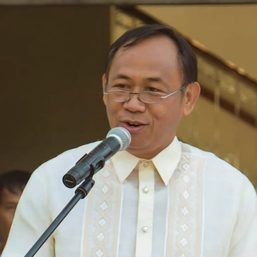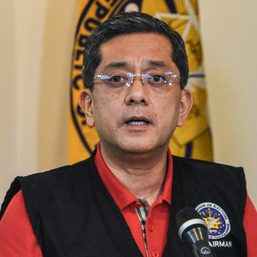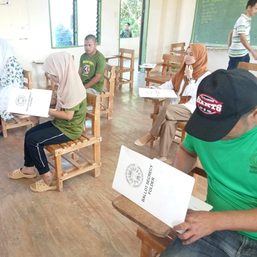SUMMARY
This is AI generated summarization, which may have errors. For context, always refer to the full article.
![[EXPLAINER] What is the proposed hybrid elections law?](https://www.rappler.com/tachyon/2021/06/hybrid-elections-sq.jpg)
The Commission on Elections (Comelec) is juggling too many things as the COVID-19 pandemic complicates preparations for the 2022 national polls. It can expect further roadblocks should lawmakers approve proposals to change the Philippines’ election system from automated to hybrid.
Congress is running out of time to have a final bill passed, and even the Comelec is worried about the feasibility of its implementation if the measure is enacted in time for May 9, 2022.
What is a hybrid election?
A hybrid election seeks to combine the old manual election system and the automated election system (AES).
Automation critics have been suspicious of the results that come out of the vote-counting machines (VCMs), arguing that there is no way to fully know whether the machines read each ballot correctly. The solution they propose is to employ a manual count of the votes.
What are the proposals?
In the House of Representatives, there are at least seven bills on hybrid elections pending with the committee on suffrage and electoral reforms.
The proponents of hybrid elections there come from various political camps. Two lawmakers hold committee leadership posts (revision of laws committee chairperson Zambales 2nd District Representative Cheryl Deloso-Montalla, and transportation committee chairman Samar 1st District Representative Edgar Sarmiento), some are members of the opposition (the six members of the Makabayan bloc), and others are political veterans (Camarines Sur 2nd District Representative LRay Villafuerte and Davao del Norte 1st District Representative Pantaleon Alvarez).
The suffrage and electoral reforms panel last tackled the bills in January 2021, but the chairperson, Negros Occidental 4th District Representative Juliet Ferrer, said Congress “cannot rush” deliberations on the matter.
At the time, among the vocal critics of proposals for hybrid elections was Deputy Speaker Rufus Rodriguez. Rodriguez, who once sat on the House of Representatives Electoral Tribunal, said none of the cases filed on electoral fraud in connection with the automated election system ever prospered.
Which proposal is gaining traction?
The hybrid elections bill in the Senate arguably has more weight. It is co-authored by Senate President Vicente Sotto III, Senator Cynthia Villar, and Senator Imee Marcos, who also chairs the committee on electoral reforms.
Senate Bill No. 1950, filed in December 2020, is a substitute bill for three similar proposals in the past. Marcos already faced interpellation on May 27, 2021. The bill is pending second reading, according to the Senate’s website.
What significant changes are proposed in SB No. 1950?
There are several changes, the most striking ones being:
- A change in the ballot design
Under this proposal, ballots will feature a square or rectangle corresponding to each name of the candidate. Voters have to place a single vertical mark across the space to register a vote. Ballots in elections since 2010 required voters to shade an oval that corresponds to their preferred candidate.
Marcos believes that the machines prefer a square or a rectangle. She argued that adopting such a proposal would spare politicians from “[embarking] on this long debate in court about 25% or 50% shading.”
Shading threshold in the ballots – or the acceptable shaded area in each oval – was a contentious issue in the electoral protest filed by Imee’s brother, defeated 2016 vice presidential candidate Ferdinand “BongBong” Marcos Jr. His case took over four years before it was ultimately junked by the Supreme Court.
- A manual count in addition to the electronic count
Voters will still feed their ballots to the machine, and will receive a receipt after.
Similar to past automated elections, once the polls close, the VCMs will be used to print copies of election returns (ERs). The election returns show the number of votes for each candidate in a precinct.
However, a manual count will also commence. Poll workers will open the VCM to get the ballots that were fed earlier in the day, and begin counting the votes.
- A provision for recount at the precinct level
The results of the manual count should match the numbers from the election returns generated by the VCM.
A recount only for a certain position will commence “if there is a discrepancy of at least two percent of the total number of the votes cast between the results of the automated system and the manual counting system,” according to the bill.
“A comparison shall be made between the digitally captured image of the ballot and the ballot itself before the recount to determine the root cause of the discrepancy and to ascertain the will of the voters,” the bill read.
“The result of the recount shall be reflected in the manually prepared election return which shall be considered, along with the unaffected electronically transmitted and digitally signed election returns, in determining the winning candidate for the subject position,” it added.
During interpellation, Marcos had said that “the manual ERs will prevail because it has been checked and digitally signed at the precinct level by the [electoral board].”
![[EXPLAINER] What is the proposed hybrid elections law?](https://img.youtube.com/vi/PJrZEJGB2cY/sddefault.jpg)
Election results under the automated system must be transmitted electronically. Election results under the manual counting system, meanwhile, must be delivered to the district or provincial canvassing centers “through the fastest means available.”
- Livestream of the vote count
Section 13 of the bill also requires the poll body to accredit groups who want to livestream the vote count. It may be used as evidence in the event of an electoral protest.
Is there time left?
In October 2020, Comelec Chairman Sheriff Abas said that, if Congress really wanted to pursue a shift to hybrid elections in 2022, a bill should be passed by January 2021.
That statement has fallen on deaf ears. On May 10, Comelec Commissioner Antonio Kho Jr. told Congress that, if ever a hybrid elections bill hurdled the legislature, there must be a provision in the measure giving the Comelec the discretion to implement it come 2025.
On May 27, Senator Marcos acknowledged suggestions to defer the potential full implementation of hybrid elections in 2022.
She, however, said a pilot rollout could still happen for the May 9, 2022, vote. It will cover four unidentified areas in Luzon and Mindanao – two rural and two urban.
Marcos insisted that a shift to hybrid polls would foster trust in the electoral process.
“The issue [here is] transparency, because our voters – I suspect for understandable reasons because our tech is so faulty – do not trust the machines, and will prefer their own teachers counting the votes physically,” she had said.
Despite criticisms of the automated election system, the random manual audit of the 2016 elections – where independent auditors manually tallied votes and compared the results with machine tallies – yielded an accuracy rate of 99.88%. In the 2019 elections, the random manual audit registered an accuracy rate of 99.99%. – Rappler.com
Add a comment
How does this make you feel?





There are no comments yet. Add your comment to start the conversation.